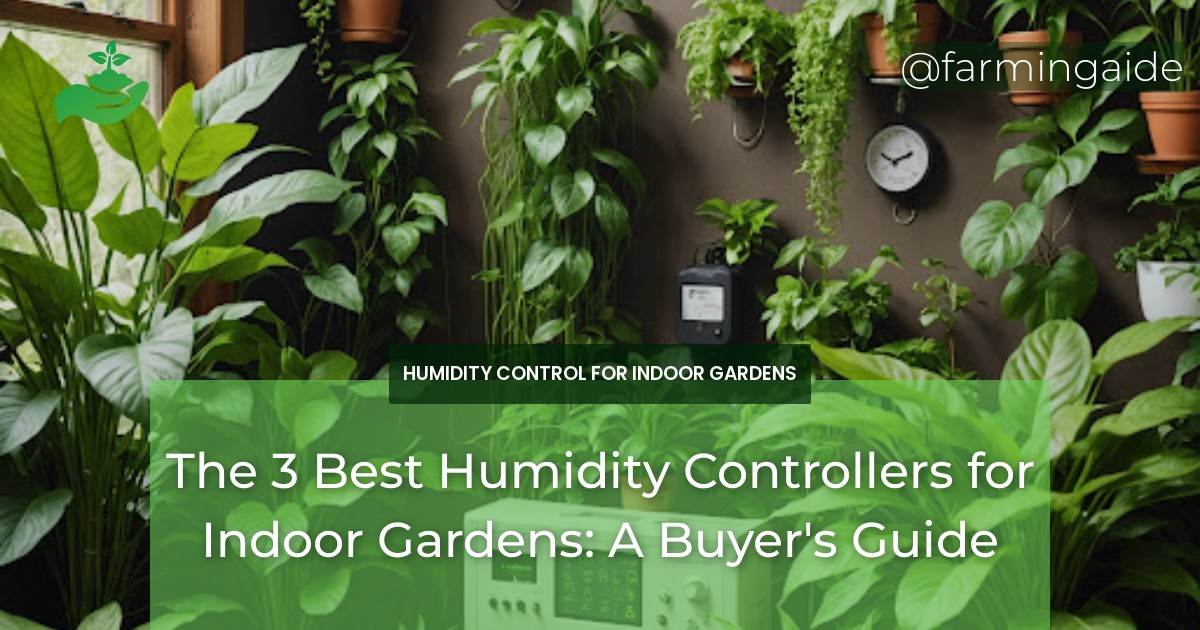As indoor gardeners, we strive to create the perfect environment for our plants to thrive. One crucial aspect of indoor gardening is maintaining optimal humidity levels, which can be a daunting task without the right tools. Humidity controllers are a game-changer in this regard, allowing you to precisely regulate the moisture levels in your garden. But with so many options available, choosing the right humidity controller can be overwhelming. In this article, we’ll explore the importance of humidity control, the ideal humidity levels for different plants, and review the top humidity controllers for indoor gardens.
Key Takeaways
- Humidity control is crucial for healthy plant growth and preventing disease.
- Ideal humidity levels vary depending on the type of plant, ranging from 40% to 80% relative humidity.
- The top humidity controllers for indoor gardens offer accuracy, ease of use, and compatibility with other garden systems.
- When choosing a humidity controller, consider factors such as precision, ease of installation, and compatibility.
- Proper installation, calibration, and maintenance are essential for optimal performance.
Understanding Humidity in Indoor Gardens
In indoor gardens, humidity plays a critical role in plant health and growth. Insufficient humidity can lead to water stress, while excessive humidity can foster disease and pests. Maintaining optimal humidity levels ensures that your plants receive the right amount of moisture, promoting healthy growth and development.
Humidity also affects the efficacy of fertilizers, pesticides, and other garden treatments. By controlling humidity, you can optimize the effectiveness of these products and minimize waste.
Importance of Humidity Control
Humidity control is essential for preventing disease and pests in indoor gardens. Fungal diseases, in particular, thrive in humid environments, making humidity control a crucial aspect of disease prevention.
In addition to disease prevention, humidity control also helps to:
- Maintain optimal plant growth and development
- Prevent water stress and root rot
- Optimize fertilizer and pesticide efficacy
Ideal Humidity Levels for Different Plants
The ideal humidity level for your indoor garden depends on the type of plants you’re growing. Here are some general guidelines for popular plants:
| Plant Type | Ideal Humidity Level |
|---|---|
| Tropical plants (e.g., orchids, ferns) | 60-80% RH |
| Herbs (e.g., basil, mint) | 50-60% RH |
| Vegetables (e.g., tomatoes, cucumbers) | 40-50% RH |
| Foliage plants (e.g., peace lilies, spider plants) | 50-60% RH |
Top Humidity Controllers Reviewed
In this section, we’ll review the top humidity controllers for indoor gardens, highlighting their features, benefits, and drawbacks.
ALSO READ
Controller A: Features and Benefits
The Controller A is a high-end humidity controller that offers precise control and advanced features. Its key features include:
- High-accuracy sensors for precise humidity readings
- Automatic humidity control with customizable setpoints
- Compatibility with multiple sensors and devices
The Controller A is ideal for large or commercial indoor gardens, offering advanced features and precision control.
Controller B: Features and Benefits
The Controller B is a mid-range humidity controller that offers a balance of features and affordability. Its key features include:
- Accurate humidity sensors with ±5% accuracy
- Manual and automatic humidity control modes
- Compact design for easy installation
The Controller B is suitable for small to medium-sized indoor gardens, offering a balance of features and affordability.
ALSO READ
Controller C: Features and Benefits
The Controller C is a budget-friendly humidity controller that offers basic features at an affordable price. Its key features include:
- Basic humidity sensors with ±10% accuracy
- Manual humidity control with simple on/off functionality
- Compact design for easy installation
The Controller C is ideal for small indoor gardens or beginners, offering a budget-friendly entry point into humidity control.
Factors to Consider When Choosing a Humidity Controller
When selecting a humidity controller, consider the following factors to ensure you choose the right one for your indoor garden:
Accuracy and Precision
Accurate humidity readings are crucial for maintaining optimal humidity levels. Look for controllers with high-accuracy sensors and precise control.
Ease of Use and Installation
Consider the ease of installation, setup, and operation when choosing a humidity controller. Look for controllers with user-friendly interfaces and simple installation procedures.
Compatibility with Other Garden Systems
If you have existing garden systems, such as ventilation or irrigation systems, ensure the humidity controller is compatible with these systems to optimize performance.
Setting Up Your Humidity Controller
Proper installation, calibration, and maintenance are essential for optimal performance:
Installation Tips
Follow the manufacturer’s installation instructions carefully, ensuring the controller is installed in a dry, secure location.
Calibration and Maintenance
Calibrate the controller according to the manufacturer’s instructions, and perform regular maintenance to ensure optimal performance.
Conclusion: Selecting the Right Humidity Controller for Your Needs
In conclusion, choosing the right humidity controller for your indoor garden depends on your specific needs and requirements. By understanding the importance of humidity control, ideal humidity levels for different plants, and factors to consider when choosing a controller, you’ll be well-equipped to select the perfect humidity controller for your indoor garden. Remember to consider accuracy, ease of use, and compatibility when making your decision, and don’t hesitate to reach out to experts if you need guidance.


